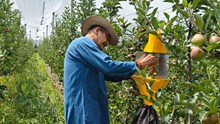
Kaji Nemu (Citrus limon), commonly referred to as Assamese lemon, is a distinct variety of lemon known for its aromatic flavor, oblong shape, and thin skin. Unlike the common lemon, Kaji Nemu has a mild tang, abundant juice, and an intense citrus aroma that enhances the taste of regional dishes. This indigenous lemon holds a special place in Assamese cuisine and cultural identity, often used in pickles, beverages, and traditional remedies.
Due to its superior quality and sensory appeal, Kaji Nemu has recently gained attention beyond northeastern India, with growing interest in its commercial cultivation and export potential.
Kaji Nemu: Ideal Climate and Soil Conditions
Kaji Nemu flourishes in subtropical to tropical climates, making Assam’s natural conditions ideal for its cultivation. The plant requires moderate temperatures, high humidity, and well-distributed rainfall throughout the year. Regions with warm days and cool nights during the flowering and fruiting period significantly boost yield and quality.
For optimal growth, the soil should be fertile, well-drained, and loamy, with a pH range between 5.5 and 6.5. Heavy clay soils or waterlogged conditions are not suitable, as they lead to root rot and poor root development. Organic matter enrichment improves soil texture and drainage, enhancing plant health and productivity.
Propagation Methods
Kaji Nemu can be propagated using three primary methods: seeds, stem cuttings, and grafting:
-
Seed propagation is suitable for small-scale cultivation or experimentation. However, it may not retain all desirable traits of the parent plant.
-
Stem cuttings taken from healthy, mature trees help ensure uniformity in fruit quality and tree characteristics.
-
Grafting onto hardy rootstocks is the most recommended method for commercial cultivation. It ensures early fruiting, disease resistance, and improved yield.
Regardless of the propagation method, the selection of disease-free and vigorous planting material is crucial for long-term orchard success.
Planting Practices
The best time to plant Kaji Nemu is during the monsoon season, particularly from June to August, when the soil has adequate moisture. The planting pits should be about 1.5 feet deep and wide, enriched with well-rotted compost or farmyard manure.
Spacing is vital to ensure proper airflow and sunlight penetration. Trees should be planted at intervals of 15 to 20 feet, depending on the landscape and management practices. Proper spacing reduces disease incidence and allows better canopy development.
Support with bamboo or wooden stakes during the initial growing phase prevents bending or wind damage in young plants.
Irrigation and Water Management
Kaji Nemu requires consistent moisture, especially during dry spells, flowering, and fruit development. While overwatering must be avoided to prevent root rot, regular irrigation is essential during the summer and post-flowering periods.
Drip irrigation or basin irrigation methods work well to deliver water directly to the root zone while conserving moisture. Mulching with organic residues like straw or dried leaves also helps retain soil moisture and suppress weeds.
Nutrient Management and Fertilization
Fertile soil alone is not sufficient; a balanced nutrient supply is critical for sustained production. Organic compost or farmyard manure should be applied annually to improve soil fertility.
Inorganic fertilizers rich in nitrogen (N), phosphorus (P), and potassium (K) must be applied in split doses throughout the growing season:
-
Nitrogen promotes vegetative growth.
-
Phosphorus supports root and flower development.
-
Potassium enhances fruit quality and resistance to pests.
Micronutrients like zinc, magnesium, and iron may also be supplemented as needed based on soil health and plant symptoms.
Pruning and Canopy Management
Regular pruning improves tree shape, encourages new shoot growth, and allows better light and air circulation. Prune the trees after the harvest or during dormancy to remove:
-
Dead or diseased branches
-
Overcrowded inner shoots
-
Branches touching the ground
Proper canopy management helps in reducing fungal diseases, especially in humid conditions, and supports uniform fruit development.
Pest and Disease Control
Kaji Nemu is susceptible to several pests and diseases common to citrus crops:
-
Aphids, citrus psyllids, and citrus leaf miners can damage new shoots and reduce photosynthetic activity.
-
Citrus canker, greening (HLB), and root rot are some of the major diseases affecting yield and plant life.
Preventive measures include:
-
Use of certified planting material
-
Regular inspection and removal of infected plant parts
-
Neem oil sprays or recommended organic pesticides
-
Maintaining field hygiene and avoiding water stagnation
Integrated pest management (IPM) strategies using a combination of biological control, organic inputs, and crop rotation are ideal for long-term sustainability.
Harvesting and Post-Harvest Handling
Kaji Nemu fruits take approximately 8 to 12 months after flowering to mature. Fruits should be harvested when they attain full size and a glossy green to light yellow colour, indicating maturity. Avoid harvesting overripe or damaged fruits to maintain market quality.
Use hand clippers or sharp tools to harvest fruits, avoiding excessive pulling, which can damage the fruit and branches. Once harvested, fruits must be handled gently to prevent bruising.
Store Kaji Nemu in cool, well-ventilated spaces away from direct sunlight. Under proper conditions, the fruits can retain freshness for two to three weeks, making them suitable for regional transport and value-added processing.
Marketing and Export Potential
Kaji Nemu holds immense commercial potential in both domestic and international markets. Its unique aroma, juiciness, and flavour make it a high-value lemon variety. In local markets, it commands a premium price, especially during festivals and peak seasons.
With growing awareness of regional produce and a rising demand for natural, chemical-free fruits, there is increasing scope for exporting Kaji Nemu to niche markets abroad. Its Geographical Indication (GI) tag, received in 2019, also enhances its brand value and authenticity.
Value addition through processing into lemon juice, pickles, concentrates, and essential oils can significantly improve farmers' income. Organized farmer collectives and agri-startups can tap into these avenues through branding, packaging, and direct marketing strategies.
Cultivating Kaji Nemu is not only a tribute to Assam’s agrarian heritage but also a promising venture for future-oriented farmers. With proper agronomic practices, pest management, and marketing strategies, this indigenous lemon can transform into a sustainable source of income. As consumer preferences shift towards native, aromatic, and naturally grown fruits, Kaji Nemu is poised to become a fragrant ambassador of Assam in both Indian and global kitchens.
















